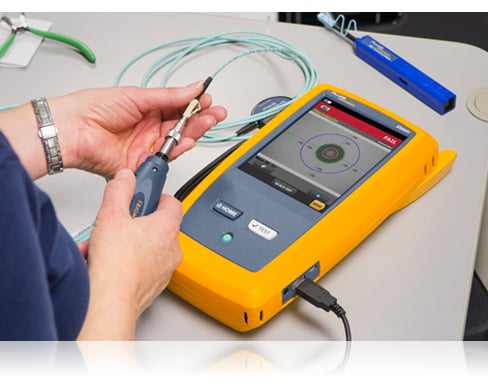The use of ofda improves fibre evaluation with innovative optical technology.
The use of ofda improves fibre evaluation with innovative optical technology.
Blog Article
Checking Out the Conveniences of Optical Fibre Testing for Boosted Communication Equipments
The importance of optical fiber testing in contemporary interaction systems can not be overstated, as it offers as a foundation for ensuring network integrity and efficiency. This positive testing strategy has profound implications for signal quality and operational effectiveness, increasing the concern of just how these practices add to long-lasting sustainability in an ever-evolving technical landscape.
Importance of Optical Fiber Screening
The relevance of optical fiber testing can not be overemphasized in today's data-driven environment. As organizations increasingly count on high-speed information transmission for day-to-day operations, the integrity and performance of optical fiber networks are paramount. Checking ensures that these networks can support the vast amounts of data created and transferred seamlessly, promoting effective communication and connectivity.
Optical fiber testing offers multiple essential features, including validating setup quality, identifying possible faults, and figuring out overall system efficiency. Normal testing can prevent pricey downtimes and service interruptions, permitting companies to preserve functional connection. Moreover, it helps in compliance with sector standards and laws, guaranteeing that fibre optic setups meet required specs for security and integrity.
Furthermore, testing can boost the durability of fibre optic systems. By proactively recognizing problems such as signal loss, attenuation, or adapter failures, companies can attend to problems prior to they intensify, hence prolonging the life of their infrastructure. In recap, optical fibre screening is not simply a technical demand but a critical investment that boosts network reliability, maximizes performance, and inevitably supports the development and efficiency of contemporary communication systems.
Secret Examining Techniques

OTDR is a crucial strategy used to determine mistakes, measure splice losses, and evaluate the overall stability of a fiber optic web link. By sending a pulse of light down the fibre and evaluating the shown light, professionals can pinpoint locations of faults and examine the network's efficiency over fars away.
Insertion loss screening gauges the quantity of signal loss that occurs when light go through a connection or splice. This technique is critical for confirming that connections meet specified loss thresholds, which is vital for keeping optimum efficiency in interaction systems.
Optical return loss screening evaluates the quantity of light reflected back towards the resource because of flaws in the fibre or links. High return loss worths suggest far better performance and decreased signal destruction.
Together, these testing approaches offer a detailed analysis of fibre optic networks, ensuring their integrity and functionality in varied communication applications.
Influence On System Efficiency
Efficient optical fibre testing straight influences the overall performance of communication systems. By ensuring the integrity of fiber optic cords, testing identifies potential mistakes such as depletion, splice loss, and connector imbalance. These concerns can dramatically break down signal high quality, causing disturbances and lowered data transmission speeds.

Moreover, regular optical fibre screening adds to lasting system sustainability. It enables early discovery of wear and tear, permitting timely maintenance and upgrades prior to major failings take place. This not only lengthens the lifespan of the framework however additionally guarantees that interaction systems remain competitive in regards to efficiency.
Cost-Effectiveness and Efficiency
Cost-effectiveness is a vital factor to consider in the deployment and maintenance of optical fiber networks. Implementing robust optical fibre screening treatments can considerably minimize functional prices by identifying problems before they rise right into significant problems. optical fibre testing equipment. By spotting faults, attenuation, and other performance limitations early, companies can stay clear of pricey repairs and downtime, which can disrupt services and bring about revenue loss
Additionally, efficient screening techniques enhance the installation procedure, enabling professionals to function better. This translates to decrease labour prices and faster job completion times. Advanced screening equipment, such as Optical Time Domain Name Reflectometers (OTDRs), makes it possible for an exact assessment of fibre top quality, fibre testing equipment guaranteeing that just ideal products are utilized, thereby lessening waste.
Regular screening also adds to better resource allocation. By comprehending the network's efficiency, organizations can make enlightened decisions concerning upgrades and expansions, making sure that investments are made where they are most needed. In summary, optical fibre screening boosts cost-effectiveness and effectiveness, supporting the lasting sustainability and competition of interaction systems in an increasingly demanding market.
Ensuring Long-Term Integrity
Carrying out extensive optical fiber testing not only boosts price savings and operational performance yet likewise plays a crucial duty in making certain the long-term dependability of communication networks. Constant screening techniques, consisting of attenuation and bandwidth evaluations, aid recognize possible degradation in fibre performance before it causes solution disturbances.
By employing advanced testing approaches, network drivers can identify mistakes or weak points in the fiber framework, permitting prompt removal. This aggressive approach minimizes downtime, ensuring that communication systems remain functional and effective. Routine screening contributes to the development of a more resistant network, as drivers can adjust and maximize their facilities based on real-time data insights.
Additionally, making certain compliance with industry standards via optical fiber testing reinforces the top quality and honesty of the entire communication system. This adherence not just boosts confidence among stakeholders but also straightens with regulative requirements, which are increasingly rigorous.
Final Thought
In verdict, optical fiber screening serves as an essential part in enhancing interaction systems. By using various testing approaches, such as OTDR and insertion loss assessments, networks can accomplish optimum efficiency and reliability.
Report this page